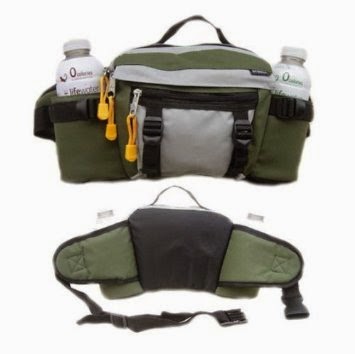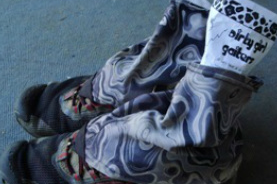

white umbrella. So I didn’t need the hat. And that black backpack wasn’t the best idea. I also should have worn a lightweight bandana. Oh, and more sunblock. Always more sunblock. The long-sleeved white shirt and hiking trousers were both excellent choices, however.
Just returned from hiking with the Rock Art Foundation in to see the spectacular rock art at Meyers Spring in the Lower Pecos of Far West Texas (yes, there will be a podcast in the Marfa Mondays Podcasting Project, in which I exploring the Big Bend & Beyond in 24 podcasts. More about that anon).
UPDATE: Listen in to the podcast interview recorded at Meyers Springs, “Gifts of the Ancient Ones: Greg Williams on the Rock Art of the Lower Pecos Canyonlands”
I got a few things very right on this trip and a few things, well, I could have done better. Herewith, for you, and for me– this will serve as my own checklist for my next rock art foray– 12 tips for summer day hiking in the desert:
1. Don’t just bring water, lots of water, more water than you think you can possibly drink– bring it cold and keep it cold.

Of course, not drinking enough water can be seriously dangerous. But warm water when it’s this hot is just bleh–and if you’re carrying a plain old plastic water bottle in your hand, out here in Texas, boy howdy… (Last year, I hiked this way over Burro Mesa in the Big Bend National Park. Six hours. Head-slapper.)
The thing is, you don’t just want to hydrate; you want to keep your core from overheating, so every swig of cold water really helps. Before heading out, fill your insulated water bottles with lots of ice. In your car, keep them in an ice chest or, if that’s not possible, wrapped in a blanket, or whatever’s handy, until the moment you have to take them out. I did this for the first time, and wow, what a difference.
> Recommended: Camelback lightweight insulated water bottle
> Recommended: Everest lumbar waist pack that holds two bottles (and carry a third in-hand).
2. Slather on the sunblock.
Yes, sun block stinks and feels gross, but if you’re like me — a descendant of those who once roamed the foggy bogs of the British Isles– if you don’t, you may end up helping your dermatologist buy his ski condo. And no, he probably won’t invite you.
> Watch this fun video, “How the Sun Sees You.”
> For those with actinic keratosis (that’s the fancy term for seriously sun-damaged skin), try Perrin’s Blend. If that doesn’t work, off to the dermatologist you must go.
> Here’s how a bald guy, Tony Overbay, dealt with actinic keratosis using the latest in dermatologist-recommended chemotherapy (uyy, I am hoping my Perrin’s Blend works…)
>Recommended: Whole Foods article on how to choose the best sunscreen.
3. Wear a long sleeved white collared shirt.
This protects you against the sun, keeps you cool (the white reflects the sun), protects you from bug bites and scratches. Light clothes always beat dark! Flip the collar up to protect your neck. About scratches: the desert tends to be filled with cactus and thorny scrub.
4. Knot a light-colored scarf around your throat.
This protects you from the sun. A bandana works fine. Mike Clelland (more about the guru in a moment) suggests cutting the bandana in two, so it’s lighter. Porquoi pas? But I didn’t do this. Alas. Bring on the Perrin’s.
5. Wear tough but lightweight trekking trousers.
For the same reason you want to wear the long-sleeved white shirt: trousers protect your body parts, in this case, calves and knees, from sun, scratches, and bugs. Do not wear shorts unless, for some reason you probably should be working on with your psychiatrist, you don’t mind scarring and blood.
And do not wear jeans. I repeat, do not wear jeans.
> Recommended: Northface trekking convertible trousers.
6. Keep your pack as light as possible, in both senses.
Hey, you’ve not only gotta stay cool, but you’ve gotta hump all that water!
A few specifics:
> Use a lightweight pack and carry it on your hips, rather than the flat of your back (see photo of lumbar waist pack above). This helps keep your back cool. But I don’t speak from experience on this one: I’m going to try this for next time.
> Carry lightweight insulated water bottles.
> Ditch the hat and ditch the heavy hiking boots (more about that below. There are, of course, other places and times when a hat and hiking books would be advisable).
> Skip the camera or use a lightweight camera (I use my iPhone).
> Eat a light breakfast and bring only a little food– since this is a day hike, you can eat a big dinner when you get back. But you will need sustenance on the trail. I recommend date, fruit and nut bars– love those Lara bars— that is, food that is high in energy but won’t spoil in the heat, and that doesn’t require any dishes or utensils. Don’t bring anything with chocolate in it. (I brought a Snicker’s bar. Ooey… gooey.)

>Bring a white plastic grocery bag and use it to cover your pack. Two advantages: the white reflects sunlight and keeps it cooler than, say, an unprotected black or other dark-colored pack, and, in case of rain, will help keep it dry.
> Highly recommended: Mike Clelland’s Ultralight Backpackin’ Tips, a superb resource for keeping it lighter-than-light, yet making sure to bring what you need for comfort and safety.

> And be sure to visit Clelland’s blog for many helpful videos and more.
7. Watch out for killer bees!
Africanized bees have arrived in some desert locales north of the Mexican border. What do bees want? Sweet things and water. So don’t carry around open cans or bottles or suddenly pick up open cans or bottles– bees may smell the water or soft drink from afar, crawl inside, and then, if you do anything they don’t like, such as pick up that can, they will go bezerk, and call in their buddies who will also go bezerk and might sting you hundreds of times.
No kidding, people and animals have died from killer bee attacks.
So be especially careful around any blooming plants where bees might be feeding. Ditto any open water, such as a tank, spring, or any puddle. And whatever you do, if you see a hive, don’t go anywhere near it. Normal honey bees, however, are not a problem. Unless you have a severe allergy, a few stings might actually be good for you! (Read more about bee sting therapy on the Apitherapy Association webpage). Your real problem is, it’s hard to tell the killers from the honeys until they attack.
8. Wear gaiters.
I followed Mike Clelland’s tip and bought a pair from Dirty Girl Gaiters (they’re for guys, too). They weigh about as much as a feather, they’re easy to attach to your lace-up running shoes and indeed, they keep the dust out.
Their biggest advantage is that you can therefore avoid wearing those ankle-high and heavy hiking boots. You’ll exert yourself less and therefore, on the margin, stay cooler. (I’ll admit however that on this last hike, a loose ball of bubble-gum cactus went right through the gaiters and stabbed me in the ankle. Oh well!)

9. Forget the hat and trekking pole; use a white umbrella.
Really! Who cares if it looks nerdy? It’s nerdier to pass out from heat stroke or end up looking like a tomato. So let those guys in jeans, black T-shirts, and baseball caps cackle all they want, as they sweat & burn & chafe.
The white umbrella protects you from sun and the rain and– crucially– helps keep your head cool. A hat will trap heat on your head– not what you want out here. Plus, in a tight spot, you can also use the umbrella as a trekking pole. Added bonus: scares mountain lions. I would think. Don’t take my word for that, however. Also good, once folded, to toss a rattlesnake or tarantula. Not that I’ve had to do that, either. Just saying.
> Golight Chrome Dome Trekking Umbrella
> Francis Tapon on Why Go Hiking with an Umbrella

10. To avoid chafing, first apply an anti-chafe roll-on or cream.
Fortunately for me, I don’t have this problem, but a lot of people do. Why suffer?
> See Top Chafing Prevention Products
11. Take it slow and rest often.
In shade, if possible. (Oh, right, you have your umbrella!)
12. In your car, leave a reflector open on your car’s dashboard and another over your stash of cold water.
If you’ve had to park outside, after a day of baking out in the desert, it’s going to be an authentic Finnish sauna in there– unless you use a dashboard reflector. In which case it will still be a chocolate-bar-melting warm, but infinitely more bearable. I picked up my pair of dashboard reflectors at Walgreen’s for $3.99 each and I was glad indeed that I did. Certainly, you could also just use ye olde roll of aluminum foil.

Notes on Tom Lea and His Epic Masterpiece of a Western, The Wonderful Country
Podcast: Cynthia McAllister with the Buzz on the Bees
Find out more about
C.M. Mayo’s books, articles, podcasts, and more.

